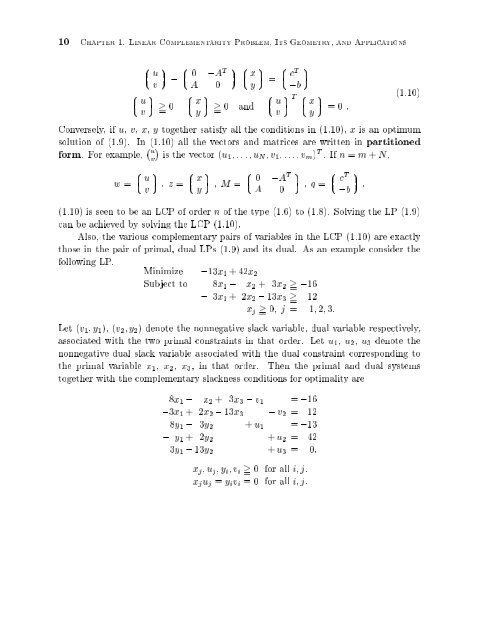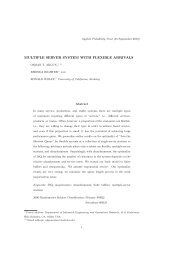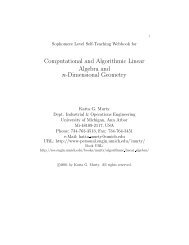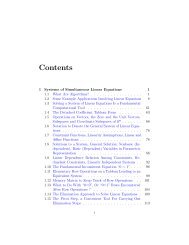Chapter 1 LINEAR COMPLEMENTARITY PROBLEM, ITS ...
Chapter 1 LINEAR COMPLEMENTARITY PROBLEM, ITS ...
Chapter 1 LINEAR COMPLEMENTARITY PROBLEM, ITS ...
Create successful ePaper yourself
Turn your PDF publications into a flip-book with our unique Google optimized e-Paper software.
10 <strong>Chapter</strong> 1. Linear Complementarity Problem, Its Geometry, and Applications<br />
8<br />
9<br />
>: u><br />
;<br />
v<br />
8<br />
>: u<br />
9<br />
> ><br />
v =<br />
0<br />
8<br />
>:<br />
8<br />
9<br />
9<br />
0 ;AT ><br />
A 0<br />
8 >: x><br />
=<br />
y<br />
>: x<br />
9 8<br />
> ><br />
y =<br />
0 and >: u<br />
v<br />
8<br />
>: cT<br />
9<br />
;b<br />
9<br />
><br />
9<br />
> T 8 >: x<br />
y<br />
> =0:<br />
(1:10)<br />
Conversely, if u, v, x, y together satisfy all the conditions in (1.10), x is an optimum<br />
solution of (1.9). In (1.10) all the vectors and matrices are written in partitioned<br />
form. For example, ; u<br />
v is the vector (u1:::uNv1:::vm) T . If n = m + N,<br />
w =<br />
8<br />
>: u<br />
v<br />
9<br />
> z =<br />
8<br />
>: x<br />
y<br />
9<br />
> M =<br />
8<br />
>:<br />
0 ;AT<br />
A 0<br />
9<br />
> q =<br />
8<br />
>: cT<br />
9<br />
> <br />
;b<br />
(1.10) is seen to be an LCP of order n of the type (1.6) to (1.8). Solving the LP (1.9)<br />
can be achieved by solving the LCP (1.10).<br />
Also, the various complementary pairs of variables in the LCP (1.10) are exactly<br />
those in the pair of primal, dual LPs (1.9) and its dual. As an example consider the<br />
following LP.<br />
Minimize ;13x1 +42x2<br />
Subject to 8x1 ; x2 + 3x2 > = ;16<br />
; 3x1 + 2x2 ; 13x3 > = 12<br />
xj > =<br />
0 j = 1 2 3:<br />
Let (v1y1), (v2y2) denote the nonnegative slack variable, dual variable respectively,<br />
associated with the two primal constraints in that order. Let u1, u2, u3 denote the<br />
nonnegative dual slack variable associated with the dual constraint corresponding to<br />
the primal variable x1, x2, x3, in that order. Then the primal and dual systems<br />
together with the complementary slackness conditions for optimality are<br />
8x1 ; x2 + 3x3 ; v1 = ;16<br />
;3x1 + 2x2 ; 13x3 ; v2 = 12<br />
8y1 ; 3y2 + u1 = ;13<br />
; y1 + 2y2 + u2 = 42<br />
3y1 ; 13y2 + u3 = 0:<br />
xjujyivi > =<br />
0 for all i j.<br />
xjuj = yivi =0 for all i j.










